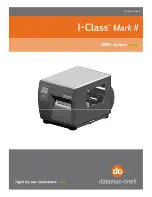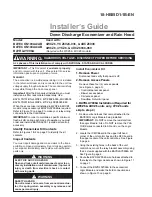
8.3.2
Process data
Modes
The device offers three different modes for reading and writing transponders.
The desired mode is selected in the ISDUs (index 0x78):
•
ReadUII Mode (value 0), default
•
Read-Write Mode (value 1)
•
Extended Read-Write Mode (value 2)
To execute an operation, a trigger source (index 0x136) must first be selected in the
ISDUs. In the PDO (Process Data OUT), the desired operation code (byte 0, bit 3 to 5)
and the addressing (offset, length) of the transponder data can be defined. By toggling
(inverting) the “Request Executed” bit (byte 0, bit 7), the defined operation is passed to
the device.
Once the operation is performed, the device transmits the transponder data in the PDI
(Process Data IN). The “Request Executed” bit and the addressing are mirrored in the
PDI.
8.3.2.1
ReadUII mode
The ReadUII mode provides the UII of the transponder within a process datum. The
device transmits max. 28 bytes of the UII. The UII consists of the PC word and the
actual EPC code. Data that exceeds 28 bytes is truncated and not transmitted. If
larger amounts of data are to be transmitted, the Read-Write Mode or the Extended
Read-Write Mode must be used instead.
Triggering is not possible in ReadUII mode. As soon as the device is in ReadUII mode,
the device starts continuous reading. In this case, no PDO (Process Data OUT) can be
written. Thus toggling (inverting) of the “Request Executed” bit is not possible. When
a transponder is read, the device automatically transmits the data in the PDI (Process
Data IN). The device indicates this with an inverted “Request Executed” bit.
The ReadUII mode is suitable for applications where only the UII has to be read. In
addition, this mode can be used for commissioning and demonstration of the device.
In addition to the UII, the device transmits the following values with each cycle:
•
RSSI value
•
Set transmitting power
•
Coding of the transponder
The ReadUII mode is the default setting.
8.3.2.2
Read-Write Mode
The device can read and write data in Read-Write Mode. The device can read and, if
necessary, write to all memory areas, such as UII, User Memory, TID and Reserved.
The transponders can be locked (Lock) and destroyed (Kill) in this mode.
In addition to the transponder data, the device transmits the following values in each
cycle:
•
RSSI value
•
Set transmitting power
•
Coding of the transponder
In addition to the desired memory area, the offset and the length of the desired data
must be set in the process data. The device can transmit a maximum of 24 bytes of
transponder data per cycle.
OPERATION
8
8026854//2021-09-01 | SICK
O P E R A T I N G I N S T R U C T I O N S | RFU61x IO-Link
41
Subject to change without notice














































